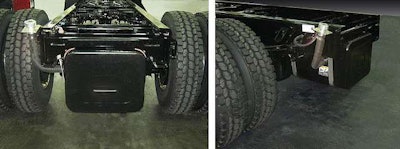
Kenworth says the enhancements are part of a focused Medium Duty Body Builder Expansion program that opens up more frame packaging options for customers with complex body installations.
“By choosing these two new options together, special application customers and their body builders will find it much easier to install custom bodies, equipment and apparatus on the Class 6 Kenworth T270 chassis and the Class 7 Kenworth T370 chassis,” says Kurt Swihart, Kenworth marketing director. “That’s great news for our customers as the new frame packaging options created by the body builder expansion program can help reduce installation time.
“The new frame packaging options could also reduce the amount of custom work body builders have to do, resulting in a potential reduction in the cost of installation.”
Kenworth says the new battery box is 6 in. narrower than the standard box, frees up space on the left-hand side for body installations and for a small DEF tank to be mounted under the cab. With this option, the air tanks are now located on the back of the cab rather than the standard placement below the battery box, the company says.
“Even though the new battery box is narrower, fleets won’t lose any battery capacity on their T270s or T370s,” Swihart says. “The new battery boxes can still accommodate two or three batteries.”

The new steel rectangular fuel tanks, mounted between the frame rails behind the rear axle, are available in 45- and 70-gallon capacities. After review of current customer capacities needed, these two capacities should support all complex body applications, Swihart says. The fuel tanks feature temporary fuel fillers, which body builders can relocate in many different ways to accommodate various bodies and equipment.
Kenworth says the tanks can also be equipped with auxiliary supply tubes for customers using generators or other apparatus. Because the tanks are supported by welded steel cross members, they can be used with or without frame inserts.
While the narrower battery box and the rear between-the-frame-rail-mounted fuel tanks can be ordered separately depending on the fleet or truck operator’s needs, Swihart notes they are designed to work in tandem to clear as much frame space as possible to make complex body installations easier.








